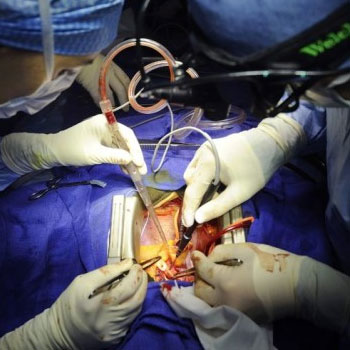What is Bypass Surgery?
Bypass surgery, also known as coronary artery bypass grafting (CABG), is a common and critical surgical procedure used to treat coronary artery disease (CAD). This condition occurs when the coronary arteries, which supply blood to the heart muscle, become narrowed or blocked. Bypass surgery aims to restore normal blood flow to the heart, thereby reducing the risk of heart attacks and improving the patient's quality of life. This article provides a detailed overview of bypass surgery, its indications, procedure, recovery, and potential risks.
What are the indications for bypass surgery?
Coronary artery disease is the primary indication for bypass surgery. CAD occurs due to the buildup of plaque a combination of fat, cholesterol, and other substances—in the coronary arteries. This buildup, known as atherosclerosis, can significantly reduce blood flow to the heart muscle, leading to chest pain (angina), shortness of breath, and other symptoms. In severe cases, it can cause a heart attack.

Doctors may recommend bypass surgery if
- Severe blockages: When one or more of the coronary arteries are significantly blocked
- Multiple artery disease: When the patient has blockages in multiple coronary arteries.
- Failed medication or angioplasty: When other treatments like medications or angioplasty (a procedure to open up the arteries) are not effective.
- Heart muscle weakness: When the heart muscle is weakened due to poor blood supply.
- Emergency situations: In some cases, such as after a heart attack, bypass surgery might be required urgently.
What is The Procedure of bypass surgery?
Bypass surgery involves creating a new pathway for blood to flow to the heart muscle. This is done by grafting a healthy blood vessel, usually taken from the patient's leg, arm, or chest, onto the blocked coronary artery. The graft bypasses the blockage, allowing blood to flow around the narrowed or blocked section of the artery.
Preoperative Preparations
Before the surgery, patients undergo a series of tests and evaluations to assess their overall health and the severity of their coronary artery disease. These tests may include
- Electrocardiogram (ECG): To measure the electrical activity of the heart.
- Echocardiogram: To visualize the heart's structure and function.
- Coronary angiography: To view the coronary arteries using X-ray imaging and a special dye.
- Blood tests: To check for other health conditions
What are the surgical steps involved in bypass surgery?
- Anesthesia: The patient is given general anesthesia to ensure they are asleep and pain-free during the surgery.
- Incision: A surgeon makes an incision in the chest, typically along the breastbone (sternotomy), to access the heart.
- Heart-Lung Machine: In most cases, the heart is temporarily stopped, and a heart-lung machine takes over the function of the heart and lungs, circulating blood and oxygen throughout the body.
- Grafting: The surgeon removes the healthy blood vessel from the leg, arm, or chest and sews it into place, creating a bypass around the blocked artery.
- Completion: The heart is restarted, and the chest incision is closed with sutures or staples.
What are The Types of Bypass Surgery?
Traditional On-Pump Surgery
The most common type, where the heart is stopped, and a heart-lung machine is used.
Off-Pump Surgery
Also known as beating-heart surgery, this procedure is performed while the heart is still beating, without the use of a heart-lung machine.
Minimally Invasive Surgery
Involves smaller incisions and may not require opening the chest bone. It is less invasive and has a quicker recovery time.
What are recovery and aftercare?
Recovery from bypass surgery involves a hospital stay of about 5-7 days, with the first few days spent in the intensive care unit (ICU). During this time, the patient's vital signs are closely monitored, and they receive medications to manage pain and prevent complications.
In-Hospital Recovery
- Monitoring: Continuous monitoring of heart function, blood pressure, and oxygen levels.
- Pain Management: Medications to control pain and discomfort.
- Physical Therapy: Gradual reintroduction to movement and light exercise to promote circulation and prevent complications.
At-Home Recovery
- Wound Care: Instructions on how to care for the incision site to prevent infection.
- Activity Restrictions: Guidelines on physical activity, including avoiding heavy lifting and strenuous activities for several weeks.
- Diet and Lifestyle Changes: Recommendations for a heart-healthy diet, smoking cessation, and stress management.
- Follow-Up Appointments: Regular check-ups with the healthcare provider to monitor recovery progress.
Long-Term Outlook
Bypass surgery is generally successful in relieving symptoms of coronary artery disease and reducing the risk of heart attacks. Most patients experience significant improvements in their quality of life and physical activity levels. However, it is important to note that bypass surgery is not a cure for coronary artery disease. Patients must adopt healthy lifestyle changes and follow medical advice to prevent the recurrence of blockages.
Bypass surgery is a life-saving procedure for individuals with severe coronary artery disease. It involves creating a new route for blood flow to the heart muscle, improving oxygen supply, and reducing the risk of heart-related complications. While the procedure carries certain risks, advancements in surgical techniques and postoperative care have significantly improved outcomes. Patients who undergo bypass surgery can look forward to a better quality of life with proper medical follow-up and lifestyle modifications.
